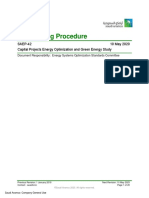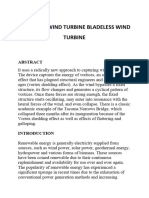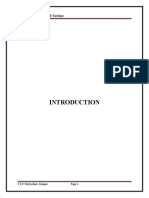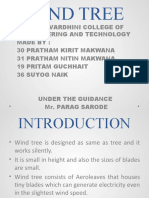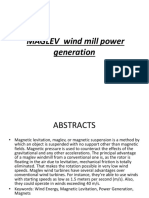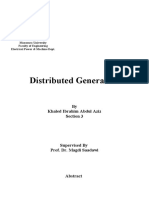Wind Energy
Wind Energy
Uploaded by
sreepraveen773Copyright:
Available Formats
Wind Energy
Wind Energy
Uploaded by
sreepraveen773Original Description:
Original Title
Copyright
Available Formats
Share this document
Did you find this document useful?
Is this content inappropriate?
Copyright:
Available Formats
Wind Energy
Wind Energy
Uploaded by
sreepraveen773Copyright:
Available Formats
DEPARTMENT OF ELECTRICAL AND ELECTRONICS ENGINEERING
CHAPTER 1
INTRODUCTION
Wind energy harnesses the kinetic energy of the wind to generate electricity. It
involves the conversion of wind's mechanical energy into electrical power using wind turbines. Wind
turbines, traditionally equipped with rotating blades, capture the wind's energy and convert it into a
usable form of electricity. Renewable energy sources, like wind energy, are of paramount importance
in addressing climate change. The burning of fossil fuels for energy has led to the release of
greenhouse gases, contributing to global warming and environmental degradation. In contrast,
renewable energy sources, such as wind power, produce minimal or zero emissions, making them a
critical component of efforts to reduce carbon emissions and combat climate change. In this context,
there is a pressing need for innovative wind turbine designs that can not only enhance energy
production but also mitigate the environmental impact of traditional turbines. The Vortex Bladeless
Wind Turbine, our seminar's focus, is an example of such innovation, aiming to revolutionize the
wind energy industry by providing a bladeless and more environmentally friendly approach to
generating clean energy. This innovative design seeks to improve efficiency, reduce maintenance
costs, and address some of the challenges associated with traditional wind turbines, further
contributing to the adoption of renewable energy and combating climate change.
GOVERNMENT POLYTECHNIC COLLEGE PALAKKAD 1
DEPARTMENT OF ELECTRICAL AND ELECTRONICS ENGINEERING
CHAPTER 2
COMPARISON
2.1Traditional Wind Turbines
Bladed Design: Traditional wind turbines consist of large, rotating blades mounted on a
horizontal or vertical axis.
Aerodynamic Lift: They rely on the principle of aerodynamic lift to harness wind energy,
causing the blades to spin and drive a generator.
Complex Maintenance: Regular maintenance is required for the moving parts, including the
blades, gearboxes, and bearings, leading to increased operational costs.
Visual Impact and Noise: The spinning blades can have a visual impact on the landscape and
produce noise, which can be a concern in residential areas.
Scaling Challenges: Scaling up traditional turbines for higher energy output can be
challenging due to structural limitations and increased costs.
2.2 Vortex Bladeless Wind Turbines
Bladeless Design: Vortex bladeless wind turbines have a unique, bladeless design where
there are no rotating blades.
Vortex-Induced Vibrations: They operate based on the principle of vortex-induced vibrations.
The wind induces oscillations in a slender, vertical structure, converting wind energy into
electricity.
Reduced Maintenance: With no blades, vortex bladeless turbines have reduced maintenance
requirements, resulting in lower operational costs.
Low Visual Impact and Noise: These turbines have a lower visual impact since there are no
spinning blades, and they produce less noise, making them more suitable for urban and
residential settings.
Adaptability: Vortex bladeless turbines are potentially more adaptable to varying wind
conditions, making them a promising choice for locations with inconsistent wind patterns.
The key difference between traditional wind turbines and vortex bladeless wind
turbines is the absence of rotating blades in the latter's design. Instead, vortex bladeless turbines rely
on a different mechanism, harnessing wind-induced vibrations to generate electricity. This
innovation aims to address some of the drawbacks associated with traditional turbines, such as
maintenance costs, visual impact, and noise, while offering the potential for greater adaptability and
efficiency in certain applications.
GOVERNMENT POLYTECHNIC COLLEGE PALAKKAD 2
DEPARTMENT OF ELECTRICAL AND ELECTRONICS ENGINEERING
CHAPTER 3
WORKING
Vortex bladeless wind turbines operate on a unique and innovative principle that differs
from traditional wind turbines. Here's an explanation of the basic working principle of vortex
bladeless wind turbines
Vortex-Induced Vibrations
The core principle behind vortex bladeless wind turbines is the phenomenon of vortex-
induced vibrations (VIV). VIV occurs when wind flows around a structure and creates
alternating vortices or patterns of swirling air.
In the case of vortex bladeless turbines, a slender, vertical structure (the mast) is positioned in
the path of the wind. As the wind flows around and past this mast, it generates vortices that
cause the mast to oscillate or vibrate in a controlled manner.
Oscillations and Resonance
The key to the turbine's energy conversion lies in controlling these vortex-induced
oscillations. The turbine is designed to resonate at the same frequency as the vortex shedding,
effectively harnessing the energy from the oscillations.
By tuning the structural properties and shape of the mast, it is possible to match the frequency
of the vortex shedding to the natural resonance frequency of the structure. This resonance
amplifies the oscillations and maximizes the energy extraction from the wind.
Generation of Electricity
The oscillations of the mast are then converted into electricity through a variety of methods.
One common approach is to use a linear generator, which is essentially a coil and magnet
system. As the mast oscillates, it moves within the coil, inducing an electric current through
electromagnetic induction.
This generated electricity can be directly used or stored for distribution, contributing to the
overall energy production.
Vortex bladeless wind turbines leverage the unique characteristics of vortex-induced
vibrations and resonance to convert wind energy into electrical power. Unlike traditional wind
turbines with rotating blades, vortex bladeless turbines have fewer moving parts and reduced
maintenance needs, making them an innovative and promising solution for clean energy generation.
Their bladeless design also has the advantage of minimizing environmental impact and noise,
making them suitable for a variety of applications, including urban and residential settings.
GOVERNMENT POLYTECHNIC COLLEGE PALAKKAD 3
DEPARTMENT OF ELECTRICAL AND ELECTRONICS ENGINEERING
Fig 3.1 : Model
GOVERNMENT POLYTECHNIC COLLEGE PALAKKAD 4
DEPARTMENT OF ELECTRICAL AND ELECTRONICS ENGINEERING
CHAPTER 4
EFFICIENCY
Efficiency Of Vortex Bladeless Wind Turbines
The efficiency of Vortex Bladeless Wind Turbines, when compared to traditional wind
turbines, is a complex consideration that depends on various factors and specific applications. Vortex
bladeless turbines offer unique advantages, particularly in terms of reduced maintenance and
environmental impact, but their efficiency in converting wind energy into electricity can vary
depending on several factors. Vortex bladeless wind turbines have the advantage of reduced
maintenance costs since they lack the complex mechanical components, like rotating blades, found in
traditional turbines. This translates into lower operational expenses and potentially longer lifespans.
Additionally, their bladeless design generates less noise and has a lower visual impact, making them
suitable for urban and residential areas, where traditional turbines may face resistance due to noise
and aesthetic concerns. However, when it comes to the conversion of wind energy into electricity,
vortex bladeless turbines may have slightly lower efficiency compared to traditional turbines. The
absence of blades means they may capture less energy from the wind, and they may not perform as
well in consistently high-wind-speed areas. Nevertheless, this lower efficiency in energy capture is
offset by their reduced maintenance and environmental benefits, making them a competitive choice
in specific settings. The efficiency of vortex bladeless wind turbines can be maximized by
optimizing the design and structure to harness vortex-induced vibrations more effectively.
Additionally, vortex bladeless turbines are adaptable and may be better suited to regions with
variable wind patterns or lower wind speeds, where their unique design can still yield significant
energy production.
In summary, the efficiency of vortex bladeless wind turbines compared to traditional turbines
depends on various factors, including the specific application, environmental considerations, and
optimization of the turbine's design. While they may capture slightly less energy from the wind, their
advantages in terms of maintenance, noise, and visual impact make them a promising option for
certain wind energy projects, particularly in urban and residential areas.
GOVERNMENT POLYTECHNIC COLLEGE PALAKKAD 5
DEPARTMENT OF ELECTRICAL AND ELECTRONICS ENGINEERING
CHAPTER 5
ADVANTAGES
Vortex Bladeless Wind Turbines offer a range of advantages that set them apart as an
innovative and promising wind energy technology. Here are the benefits of this technology
1. Reduced Maintenance Costs (No Blades):One of the standout advantages of vortex bladeless
turbines is the absence of rotating blades. Traditional wind turbines with blades require
regular maintenance, which can be expensive and pose logistical challenges. Vortex bladeless
turbines eliminate this need for blade maintenance, leading to significantly reduced
operational costs.
2. Lower Environmental Impact: Vortex bladeless wind turbines have a reduced environmental
impact compared to traditional turbines. Their bladeless design is less harmful to birds and
bats, addressing concerns about wildlife conservation. Additionally, the absence of blades
means there are fewer risks of ice throw, which can be hazardous in cold climates.
3. Less Noise and Visual Disruption: Traditional wind turbines are known for the noise they
generate due to the rotation of blades. In contrast, vortex bladeless turbines produce less noise
because they lack rotating parts, making them more suitable for urban and residential areas
where noise can be a significant concern. Their sleek and non-obtrusive design also
minimizes visual disruption, making them aesthetically appealing and more readily accepted
in various settings.
4. Adaptability to Various Wind Conditions: Vortex bladeless wind turbines exhibit greater
adaptability to varying wind conditions. Their ability to harness wind-induced vibrations
means they can work effectively in locations with fluctuating wind patterns or lower average
wind speeds. This adaptability expands the range of potential applications for this technology.
These advantages collectively position vortex bladeless wind turbines as a promising
and eco-friendly choice in the field of wind energy. Their unique design addresses several drawbacks
associated with traditional wind turbines, making them particularly appealing for urban, residential,
and environmentally sensitive areas, where minimizing maintenance, noise, and visual disruption is
essential for the wider acceptance of wind energy projects.
GOVERNMENT POLYTECHNIC COLLEGE PALAKKAD 6
DEPARTMENT OF ELECTRICAL AND ELECTRONICS ENGINEERING
Fig 5.1 : Vortex Bladeless Wind Turbines
GOVERNMENT POLYTECHNIC COLLEGE PALAKKAD 7
DEPARTMENT OF ELECTRICAL AND ELECTRONICS ENGINEERING
CHAPTER 6
CHALLENGES
While vortex bladeless wind turbines offer numerous advantages, they also face several
challenges and limitations that are important to consider:
1. Efficiency Compared to Traditional Turbines: One of the primary challenges is the efficiency
of vortex bladeless wind turbines when compared to traditional wind turbines with rotating
blades. The absence of blades means they may capture less wind energy, which can affect
their overall energy conversion efficiency. In consistently high-wind-speed areas, traditional
turbines may outperform vortex bladeless turbines in terms of energy capture. However, this
efficiency gap is offset by other advantages, such as reduced maintenance costs and
environmental benefits.
2. Scaling Issues: Scaling up vortex bladeless wind turbines for higher energy output can be
challenging. As turbines become larger, structural considerations and materials must be
carefully addressed to ensure stability and longevity. Additionally, the resonance and
frequency tuning required for efficient energy conversion become more complex as the size
of the turbine increases. Addressing these scaling challenges is crucial for the widespread
adoption of this technology in larger wind farms.
3. Technical Challenges in Harnessing Energy from Vibrations: The technology behind vortex
bladeless wind turbines relies on harnessing energy from vortex-induced vibrations of the
turbine structure. This approach involves complex engineering to ensure that the vibrations
resonate at the correct frequency and amplitude for effective energy conversion. Achieving
the precise tuning and control required for optimal performance can be technically
challenging and may necessitate ongoing research and development efforts.
Understanding and addressing these challenges and limitations is essential for the
continued development and deployment of vortex bladeless wind turbines. While they may have
efficiency trade-offs compared to traditional turbines, their unique advantages in terms of reduced
maintenance, lower environmental impact, and adaptability to diverse settings make them a valuable
addition to the renewable energy landscape, particularly in urban and residential environments where
other wind turbines may face greater obstacles.
GOVERNMENT POLYTECHNIC COLLEGE PALAKKAD 8
DEPARTMENT OF ELECTRICAL AND ELECTRONICS ENGINEERING
CHAPTER 7
APPLICATIONS
Vortex bladeless wind turbines exhibit versatility and can be applied in various settings
and industries, offering innovative solutions for harnessing wind energy. Here are potential
applications for this technology
Urban Environments: Vortex bladeless wind turbines are well-suited for urban areas where
the visual and noise impact of traditional wind turbines can be a concern. Their bladeless
design and reduced noise make them an attractive choice for incorporating renewable energy
generation within cities. They can be installed on rooftops, streetlights, or other structures in
urban environments, contributing to localized clean energy production.
Off-Grid and Remote Areas: In off-grid and remote areas where a reliable power supply is a
challenge, vortex bladeless wind turbines offer a sustainable energy solution. These turbines
can be deployed in remote locations to provide electricity for small communities, agricultural
operations, or research stations, reducing dependence on fossil fuels and improving energy
access.
Sustainable Energy Solutions in Various Industries: Vortex bladeless wind turbines can find
applications in diverse industries. For example:
Agriculture: They can power irrigation systems, reducing the reliance on diesel generators.
Mining and Minerals Processing: These turbines can be used to provide energy for equipment
and lighting in remote mining operations.
Telecommunications: They can serve as a supplementary power source for remote cell
towers, ensuring uninterrupted communication services.
Military Installations: Vortex bladeless turbines can be deployed on military bases to enhance
energy security and reduce environmental impact.
Marine and Shipping: These turbines may provide power for navigation aids and small
vessels, promoting sustainability in maritime operations.
By offering an energy solution that is well-suited for a variety of applications, vortex
bladeless wind turbines have the potential to contribute to cleaner and more sustainable energy
practices in urban areas, remote regions, and diverse industrial sectors. Their adaptability and
reduced environmental impact make them a valuable addition to the renewable energy landscape,
addressing specific energy needs while mitigating some of the challenges associated with traditional
wind turbines.
GOVERNMENT POLYTECHNIC COLLEGE PALAKKAD 9
DEPARTMENT OF ELECTRICAL AND ELECTRONICS ENGINEERING
CHAPTER 8
FUTURE SCOPE
The Future Scope of the vortex bladeless wind turbine industry hold significant promise and
could play a pivotal role in the global transition to renewable energy sources. As the world
increasingly recognizes the importance of reducing greenhouse gas emissions and mitigating climate
change, the demand for innovative and sustainable energy solutions continues to grow. In this
context, vortex bladeless wind turbines offer several key factors that contribute to their bright future
Environmental Benefits: Vortex bladeless wind turbines significantly reduce the
environmental impact associated with traditional wind turbines. Their bladeless design makes
them safer for birds and bats, and they eliminate risks such as ice throw. This environmental
compatibility positions them as a compelling choice for renewable energy projects, especially
in ecologically sensitive areas.
Urban Integration: The ability of vortex bladeless turbines to operate effectively in urban
environments addresses the need for distributed renewable energy generation within cities.
They can be installed in urban areas without causing the noise and visual disruption typically
associated with traditional turbines, making them an ideal fit for urban sustainability
initiatives.
Adaptability to Wind Conditions: Vortex bladeless wind turbines have demonstrated
adaptability to varying wind conditions, making them suitable for locations with fluctuating
wind patterns or lower average wind speeds. This adaptability extends their application range
and allows for increased energy production in a broader set of environments.
In the broader context of the transition to renewable energy sources, vortex bladeless wind
turbines offer an innovative and sustainable alternative to traditional wind turbines. Their potential to
expand the deployment of wind energy into urban areas, reduce environmental impact, and lower
costs positions them as a valuable contributor to the global effort to mitigate climate change. As
research and development efforts continue, and as the industry gains more experience and
understanding, vortex bladeless wind turbines are poised to become a significant player in the
renewable energy landscape, supporting the transition to cleaner and more sustainable sources of
power.
GOVERNMENT POLYTECHNIC COLLEGE PALAKKAD 10
DEPARTMENT OF ELECTRICAL AND ELECTRONICS ENGINEERING
CONCLUSION
In Conclusion, the seminar topic of "Vortex Bladeless Wind Turbines" highlights an
innovative and environmentally friendly approach to wind energy generation. These bladeless
turbines offer a unique solution to the challenges associated with traditional wind turbines,
presenting a host of advantages that include reduced maintenance costs, lower environmental impact,
and adaptability to various settings, including urban environments. While challenges such as
efficiency compared to traditional turbines and scaling issues exist, ongoing research and
development efforts hold the potential to address these concerns and further enhance the technology's
performance. In an era marked by the urgent need for sustainable energy sources and climate change
mitigation, vortex bladeless wind turbines stand as a promising addition to the renewable energy
landscape. Their ability to generate clean energy with fewer drawbacks in noise and aesthetics
positions them as an ideal choice for urban and residential applications. With their potential to make
wind energy more accessible and environmentally friendly, vortex bladeless wind turbines represent
a significant step forward in the global transition to cleaner and more sustainable sources of power.
As the industry evolves and technology advances, we can anticipate even more widespread adoption
of this innovative solution, contributing to a greener and more sustainable future.
GOVERNMENT POLYTECHNIC COLLEGE PALAKKAD 11
DEPARTMENT OF ELECTRICAL AND ELECTRONICS ENGINEERING
REFERENCES
[1] VortexBladeless.com
[2] https/Wikipedia
[3] Bridgestone.com
GOVERNMENT POLYTECHNIC COLLEGE PALAKKAD 12
You might also like
- Saep 42Document20 pagesSaep 42AbdullahNo ratings yet
- 1.1 History of Bladeless Power GenerationDocument12 pages1.1 History of Bladeless Power GenerationRahul TiwariNo ratings yet
- Bladeless Wind Turbine: Holy Mary Institute of Technology & Science Hyderabad, TelanganaDocument18 pagesBladeless Wind Turbine: Holy Mary Institute of Technology & Science Hyderabad, TelanganaTesterNo ratings yet
- Sample Seminar ReportDocument22 pagesSample Seminar ReportIsmail Rohit Rebal50% (2)
- Bladeless Wind Turbine Bladeless Wind TurbineDocument9 pagesBladeless Wind Turbine Bladeless Wind TurbinemukilantamilvananNo ratings yet
- List of Acronyms: Vawt:-Vertical Axis Wind Turbine V: - Voltage KWH: - Kilo Watt Hour Led: - LightDocument12 pagesList of Acronyms: Vawt:-Vertical Axis Wind Turbine V: - Voltage KWH: - Kilo Watt Hour Led: - LightBiniyamNo ratings yet
- Wind Mill With 3 BladesDocument43 pagesWind Mill With 3 BladesABnB InnovationsNo ratings yet
- Technical Seminar On: Bladeless Wind TurbineDocument24 pagesTechnical Seminar On: Bladeless Wind TurbineBHUKYA GandhiNo ratings yet
- Final ArchimedesDocument8 pagesFinal ArchimedesYash50% (2)
- Fabrication of Bladeless Wind Turbine-1Document10 pagesFabrication of Bladeless Wind Turbine-1SHAJAKHAN RNo ratings yet
- Abhay ReportDocument46 pagesAbhay ReportAnuj TripathiNo ratings yet
- Bladeless Windmill: PC Polytechnic, Mechanical DepartmentDocument21 pagesBladeless Windmill: PC Polytechnic, Mechanical Departmentvaibhav babarNo ratings yet
- Chronological History of Wind Turbine TechnologyDocument2 pagesChronological History of Wind Turbine TechnologyDeepak AshokanNo ratings yet
- Sambhram Institute of Technology: Department of Mechanical EngineeringDocument13 pagesSambhram Institute of Technology: Department of Mechanical Engineeringnachi stinnuNo ratings yet
- Suspended Frictionless Windmill: Presentation OnDocument17 pagesSuspended Frictionless Windmill: Presentation OnShri PatilNo ratings yet
- Wind LensDocument24 pagesWind LensakshithaNo ratings yet
- Vortex Bladeless Wind TurbineDocument4 pagesVortex Bladeless Wind TurbineVIVA-TECH IJRINo ratings yet
- Harnessing The Breeze Innovations in Wind Turbines - 20240204 - 232558 - 0000Document2 pagesHarnessing The Breeze Innovations in Wind Turbines - 20240204 - 232558 - 0000YESHASWINI PANDILWARNo ratings yet
- Aeroelastic Flutter Energy HarvestingDocument3 pagesAeroelastic Flutter Energy HarvestingAnonymous CUPykm6DZNo ratings yet
- Vertical Wind Mill Turbie EditedDocument28 pagesVertical Wind Mill Turbie EditedAbhijeet DhavaleNo ratings yet
- MidunDocument34 pagesMidunmraj78293No ratings yet
- Wind TreeDocument18 pagesWind TreeA48Rayan PereiraNo ratings yet
- Vertical Axis Wind Turbine ProjectDocument23 pagesVertical Axis Wind Turbine Project190 241 Rohan PatilNo ratings yet
- Parala Maharaja Engineering CollegeDocument23 pagesParala Maharaja Engineering CollegeJaal TaabNo ratings yet
- IJCRT2210185Document5 pagesIJCRT2210185arainshoaib6671No ratings yet
- Modified Wind TurbineDocument2 pagesModified Wind TurbineUNITED CADDNo ratings yet
- Irjet V8i4889Document4 pagesIrjet V8i4889d v rama krishnaNo ratings yet
- Vortex Bladeless WindmillDocument13 pagesVortex Bladeless Windmillnachi stinnuNo ratings yet
- Energy Harvesting PresentationDocument15 pagesEnergy Harvesting PresentationHarsh GautamNo ratings yet
- Wind-Energy-Collectors NewDocument14 pagesWind-Energy-Collectors Newashiq2023meleep002No ratings yet
- Power Generation From Small Wind MillDocument5 pagesPower Generation From Small Wind MillSiginam VineethNo ratings yet
- Wind Power TurbineDocument23 pagesWind Power Turbinem arslan juttNo ratings yet
- Piezoelectric Wind TurbineDocument8 pagesPiezoelectric Wind TurbineMohan KumarNo ratings yet
- Design of Micro Wind Turbine For Low Win 2974cb89Document6 pagesDesign of Micro Wind Turbine For Low Win 2974cb89Agung Kus SugihartoNo ratings yet
- Design of Micro Wind Turbine For Low Win 2974cb89Document6 pagesDesign of Micro Wind Turbine For Low Win 2974cb89samuelmardianmanullangNo ratings yet
- Gandhi Seminar21Document25 pagesGandhi Seminar21Bhukya GandhiNo ratings yet
- MAJORDocument18 pagesMAJORAbhishek KumarNo ratings yet
- Wind Farm Industrial ProcessDocument18 pagesWind Farm Industrial ProcessMike Cajes AsiadoNo ratings yet
- MAGLEV Wind Mill Power GenerationDocument16 pagesMAGLEV Wind Mill Power GenerationNagabhushanaNo ratings yet
- Vortex Bladeless Wind TurbineDocument17 pagesVortex Bladeless Wind TurbineFahad AhamedNo ratings yet
- EST Microproject ReportDocument9 pagesEST Microproject Reportprokiller3605No ratings yet
- What Is A Wind Turbine and How Does It Work?Document3 pagesWhat Is A Wind Turbine and How Does It Work?Jacellie BailenNo ratings yet
- Sudarshan 2023 J. Phys. Conf. Ser. 2426 012059Document9 pagesSudarshan 2023 J. Phys. Conf. Ser. 2426 012059I Made Widhi SuryawanNo ratings yet
- Floating Solar Chimney TechnologyDocument11 pagesFloating Solar Chimney TechnologyBhushanNo ratings yet
- Windmill: Power Generation Using Wind EnergyDocument23 pagesWindmill: Power Generation Using Wind EnergyAlok Ranjan Pandey100% (1)
- iae ii ans keyDocument8 pagesiae ii ans keyNIJANTHANNo ratings yet
- Major Project PresentationDocument15 pagesMajor Project Presentationaadarshpatil988No ratings yet
- Design of An Ornamental Bladeless Vortex GeneratorDocument5 pagesDesign of An Ornamental Bladeless Vortex GeneratorKYLE LEIGHZANDER VICENTENo ratings yet
- Seminar 35Document2 pagesSeminar 35Abhishek srNo ratings yet
- WindmillDocument4 pagesWindmillthisisspam10000No ratings yet
- Design and Fabrication of Vortex Bladeless TurbineDocument11 pagesDesign and Fabrication of Vortex Bladeless Turbinesiddam maheshNo ratings yet
- ... A Transformer Less Compact and Light Wind Turbine Generating System For Offshore Wind FarmsDocument7 pages... A Transformer Less Compact and Light Wind Turbine Generating System For Offshore Wind FarmselginNo ratings yet
- Hybrid Power GenDocument21 pagesHybrid Power GenBALASUBRAMANIYAM SNo ratings yet
- Spiral Turbine DesignDocument5 pagesSpiral Turbine DesignDidel DraguNo ratings yet
- A Review On Vertical Axis Wind Solar Hybrid Power System: Sumit Wagh, Pratik Dhage, Amit GavhadDocument7 pagesA Review On Vertical Axis Wind Solar Hybrid Power System: Sumit Wagh, Pratik Dhage, Amit GavhadshamNo ratings yet
- Remf-150 Fabrication of Hybrid Power Generation From HighwayDocument4 pagesRemf-150 Fabrication of Hybrid Power Generation From HighwayretechNo ratings yet
- Chapter 2Document18 pagesChapter 2U Aung Myint NaingNo ratings yet
- Vortex Wind TurbinesDocument5 pagesVortex Wind TurbinesfdiljhNo ratings yet
- Project Report On Smart Vertical Axis Highway Wind TurbineDocument7 pagesProject Report On Smart Vertical Axis Highway Wind TurbineSandeep JaiswalNo ratings yet
- Chapter Final FinalsDocument73 pagesChapter Final Finalsklenn dayoNo ratings yet
- Renewable Energy Dreams Become Reality Ielts Reading AnswersDocument2 pagesRenewable Energy Dreams Become Reality Ielts Reading Answersisaevadildora94No ratings yet
- Solar PPA - Cover LetterDocument2 pagesSolar PPA - Cover LetterEditor, Hartford CourantNo ratings yet
- From The Fryer To The Fuel TankDocument177 pagesFrom The Fryer To The Fuel Tankncexcqux100% (1)
- B.tech MeDocument21 pagesB.tech Memdmsc87No ratings yet
- MHOD District Cooling - Arup 29-09-2011Document52 pagesMHOD District Cooling - Arup 29-09-2011Mrityunjay MallikNo ratings yet
- Investigationof Renewable Energy PotentialDocument6 pagesInvestigationof Renewable Energy PotentialMohd Faisal JalilNo ratings yet
- Eco RightDocument84 pagesEco RightJesse RobertNo ratings yet
- CBSE Class 10 Science Chapter 14 Sources of Energy Important Questions 2022-23Document21 pagesCBSE Class 10 Science Chapter 14 Sources of Energy Important Questions 2022-23S MNo ratings yet
- A Deep Geothermal Exploration Well at Eastgate, Weardale, UK, A Novel Exploration Concept For Low Enthalpy ResourcesDocument12 pagesA Deep Geothermal Exploration Well at Eastgate, Weardale, UK, A Novel Exploration Concept For Low Enthalpy ResourcesHanaga ShenNo ratings yet
- Renewable Energy Sources From The Perspective of Blockchain Integration - From Theory To ApplicationDocument26 pagesRenewable Energy Sources From The Perspective of Blockchain Integration - From Theory To Applicationamalgade24No ratings yet
- 5NRJHL Saipem FY2020 Results JMEEBODocument42 pages5NRJHL Saipem FY2020 Results JMEEBOsudhakarrrrrrNo ratings yet
- Kansas Legislative Briefing Book, 2014Document411 pagesKansas Legislative Briefing Book, 2014Bob WeeksNo ratings yet
- Sources of EnergyDocument43 pagesSources of EnergyEhh HedayahNo ratings yet
- Paper 1 - Set B Solutions: General InstructionsDocument16 pagesPaper 1 - Set B Solutions: General Instructionsadir royNo ratings yet
- Distributed Generation: by Khaled Ibrahim Abdul Aziz Section 3Document11 pagesDistributed Generation: by Khaled Ibrahim Abdul Aziz Section 3Khaled IbrahimNo ratings yet
- Environmental TechnologyDocument3 pagesEnvironmental Technologynisarg_No ratings yet
- Regulatory Brief - UPERC Connectivity Regulations 1st AmendmentDocument2 pagesRegulatory Brief - UPERC Connectivity Regulations 1st AmendmentabhushanNo ratings yet
- SP-M60 Series 295 W - 315 W Key Features: 22 % 1500 V 10 Year 25 YearDocument2 pagesSP-M60 Series 295 W - 315 W Key Features: 22 % 1500 V 10 Year 25 YearscribdgineerNo ratings yet
- Indian Power Sector Deja Vu 2008 Final 241026 213837Document15 pagesIndian Power Sector Deja Vu 2008 Final 241026 213837sanyal.chincholikarNo ratings yet
- Design and Simulation of A Rooftop Solar PV System Using PVsyst SoftwareDocument5 pagesDesign and Simulation of A Rooftop Solar PV System Using PVsyst Softwarefatemeh mohammadiNo ratings yet
- Solar SolutionDocument2 pagesSolar SolutionJuan Miguel SilvestreNo ratings yet
- Asec. Richie Ramos (DOE)Document27 pagesAsec. Richie Ramos (DOE)Stratbase ADR InstituteNo ratings yet
- Solar Energy Questions HandbookDocument17 pagesSolar Energy Questions HandbookMuhammadTouseefNo ratings yet
- Assignment 2 Third CourseDocument15 pagesAssignment 2 Third Coursearbaan malikNo ratings yet
- Geothermal For EveryoneDocument37 pagesGeothermal For EveryoneRamanuzha GunawanNo ratings yet
- AC Modules: Past, Present and Future: Workshop Installing The Solar Solution, 22-23 January 1998, Hatfield, UKDocument6 pagesAC Modules: Past, Present and Future: Workshop Installing The Solar Solution, 22-23 January 1998, Hatfield, UKJoão SouzaNo ratings yet
- Polar Bears - Endangered Species List HOMEWORK READINGDocument7 pagesPolar Bears - Endangered Species List HOMEWORK READINGCrystal LeeNo ratings yet
- Assessing Opportunities To Exploit Stranded Power - Andrew ChienDocument21 pagesAssessing Opportunities To Exploit Stranded Power - Andrew ChienUCSBieeNo ratings yet
